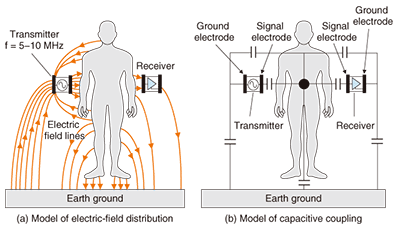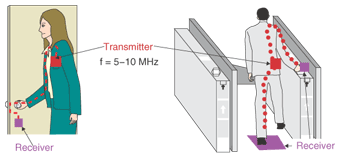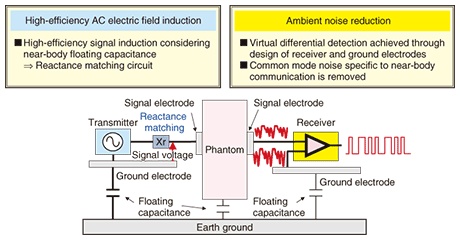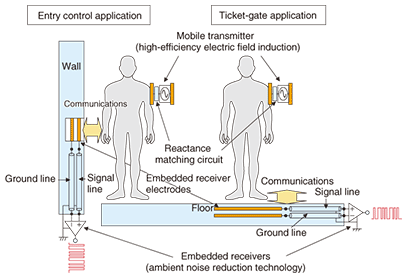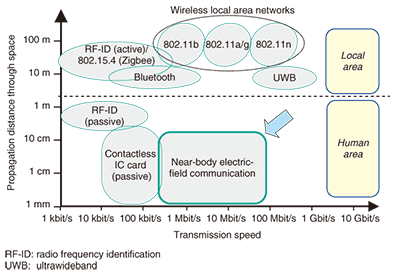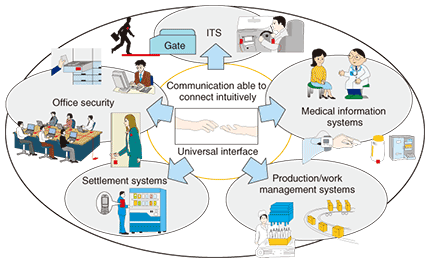 |
|||||||||||
|
|
|||||||||||
|
Special Feature: Trends and Business Prospects for Human-area Networking Technology––Connecting People, Objects, and Networks Vol. 8, No. 3, pp. 1–6, Mar. 2010. https://doi.org/10.53829/ntr201003sf1 RedTacton Near-body Electric-field Communications Technology and Its ApplicationsAbstractWe discuss the background and principles for the development of near-human-body electric-field communications technology and describe two key techniques for establishing stable communications: efficient electric-field induction and ambient noise reduction. We also describe the features of this communications technology, clarify differences from conventional short-range wireless technologies, and discuss its application areas.
1. IntroductionThe near-body electric-field communication system described in this Special Feature consists of (1) a transmitter that emits an alternating current (AC) electric-field signal modulated by input data from an electrode and (2) a receiver that uses another electrode to read the weak AC electric field on the body induced by the signal and demodulates it to recover the data from it (Fig. 1).
The transmitter and receiver are capacitively coupled to the human body through flat electrodes that are equivalent to the antennas in regular wireless systems. The near-body electric field is modulated and can be read and demodulated through these couplings. A feature of the technology is that, because the signal is passed to and from the body’s surface through this capacitive coupling, it can be transmitted between transmitter and receiver via the body’s surface, even if one of them is in the user’s pocket, and the other is under the carpet on the floor, for example. If this technology is applied to an entry control system or ticket gate, it is much more convenient than conventional contactless cards because you do not even need to remove the access card from your pocket (Fig. 2). Other features of the near-body electric-field communications technology are that it suppresses the emission of the electric field from the body into space, so mutual interference is reduced, and it enables intuitive connection through touch communication since the signal propagates over the bodily surface.
The first person to study this sort of electric-field communications technology, as a means of communication among multiple wearable computers that users would attach to their bodies, was T. G. Zimmerman, who was at IBM at the time. He envisioned the body as a signal bus between the computers and proposed an electric-field technology using an AC electric field ranging from 0.1 to 1 MHz. He built a prototype electric-field communications system using 330 kHz and demonstrated the potential of the concept [1]. However, he chose the frequency range from 0.1 to 1.0 MHz to limit electric-field emissions, which probably made it difficult to achieve stable communication without transmitting a strong signal because of the significant amount of ambient noise that is usually normally present at frequencies below 1 MHz. When the transmission signal is strong, a stronger electric field is emitted around the body, reducing differentiation from other short-range wireless technologies. Ultimately, Zimmerman stopped development of the technology in favor of other short-range wireless technologies such as Wi-Fi and Bluetooth [2]. A key aspect of the technology is the behavior of the AC electric field, which can be summarized in terms of three components produced around the body when an AC signal is applied to a parallel-plate electrode attached to the body. These components, which are all related to distance r from the body, are: the quasi-static electric field (proportional to 1/r3), the induced electric field (proportional to 1/r2), and the emitted electric field (proportional to 1/r). Our near-body electric-field communications technology uses the quasi-static electric field, which attenuates steeply with r, and we can say that it suppresses both the induced and radiated field components. To suppress these emissions, we use a low frequency to drive the transmitter electrode, higher receiver sensitivity, and the minimum required power for the transmitter. From the beginning, we were aware of the above mentioned technical background, so we selected the frequency band from 5 to 10 MHz and developed ways of modulating the near-body electric field efficiently and reducing ambient noise such as electrical hum in the receiver circuits. This enabled us to develop a near-body quasi-static electric-field communications technology capable of providing the quality required for communications services while using a minimum level of power in the transmitter. We selected this frequency range to avoid the strong environmental noise below 1 MHz and to control electric-field emissions from the human body and the transmitter electrodes. We have confirmed that the actual electric field produced by our prototype transmitter is an order of magnitude smaller than regulation levels for short-range wireless schemes. 2. Principles and strengths of the technologyA model of the distribution of the electric field around the human body is shown in Fig. 1(a). Here, the human body is standing above the earth ground, and both the transmitter and receiver have signal and ground electrodes. An AC field can be transmitted to the body’s surface if the transmitter is capacitively coupled to the body (Fig. 1(b)), so the electrode is isolated with an insulating layer. If the AC signal is in the 5–10 MHz band, the body can be treated essentially as a conductor, and for the most part, the AC electric field induced by the transmitter does not radiate into the region of space around the body, but is transmitted over the body’s surface and escapes to the earth ground. Communication is achieved in the receiver by detecting this AC electrical field before it escapes to the earth ground. However, part of the AC electric field induced on the body returns to the ground on the transmitter, and a significant part escapes directly to the earth ground. The field distribution also changes continuously as the person moves, so the receiver must detect a signal that is very faint and unstable, which is a challenge for ensuring stable communications. First, we describe the key factors for the transmitter and receiver with reference to a simple equivalent circuit model (Fig. 3).
For the transmitter, it is important to somehow efficiently induce a stable AC electric-field signal on the body’s surface. Both the body and the transmitter are floating with respect to the earth ground and are loosely coupled to it through this floating capacitance. This capacitance tends to attenuate the AC signal induced by the transmitter, and the value of this floating capacitance changes continuously with body movements. To get efficient induction of a stable AC electric field, we need to control the effects of this floating capacitance. We introduced a variable reactance circuit into the output stages of the transmitter: when there is resonance between the floating capacitance and the reactance circuit, the induced signal is maximized. We also added a function enabling the reactance circuit to follow changes in this floating capacitance as the body moves, resonating with it. Similar to the transmitter, the receiver is electrically floating with respect to the earth ground, as shown in Fig. 4. If common mode noise is introduced, it has a strong effect because the impedance balance between the signal and ground lines is poor. To detect the weak AC electric field arriving at the receiver electrode, it is important to somehow control common mode noise. To do this, we created a differential structure in the initial stage amplifier of the receiver and developed technology with a careful design from the receiver electrode to the positive input of the initial stage low-noise amplifier and from the ground electrode to the negative input terminal to achieve an equivalent differential structure. In this way we were able to reliably remove common-mode noise at the initial-stage amplifier and improve the signal-to-noise ratio, creating a highly sensitive architecture able to amplify the weak signal.
Using the basic technologies described above, we were able to efficiently modulate the near-body electric field and implement a receiver that can reduce ambient noise to develop a near-body quasi-electric-field communications technology that achieves the quality required to offer communications services and operates at a minimal transmission power level. A prototype portable card transmitter and a receiver that can be built into environments such as doors or floors are shown in Fig. 5. The system uses a carrier frequency of 5 MHz and binary phase shift keying (BPSK) modulation and achieves transmission speeds of 200 kbit/s. In some typical applications including entry control and ticket gate systems, with the transmitter carried in a jacket breast pocket or trouser pocket transmitting an ID, we achieved communication with a packet error of rate of less than 10–3. The transmitter can operate for approximately one year using a single CR3032 button-type lithium-ion battery.
3. Applications and future developmentsThis communications technology, which transmits signals using an electric field induced on the body’s surface, could be used to transmit an ID and initiate various actions when you simply use a part of your body such as a hand, foot, or the torso to briefly touch a receiver plate embedded in an object, such as the floor, a door, or a piece of office equipment. The business-card-sized transmitter emitting the ID information could be attached to any part of the body. With a simple touch, the technology can trigger various responses (act on), so we coined the word tacton to express the combination of these two ideas. Since the color red symbolizes the warmth of touch, we gave our technology the name RedTacton [3], [4]. To highlight the fact that communication is only with the touched object, we compared it with other popular short-range wireless and contactless-card technologies in terms of transmission speed and propagation distance through space (Fig. 6). RedTacton limits the propagation through space to a range similar to contactless cards and targets transmission speeds from 100 kbit/s to 10 Mbit/s. In contrast to technologies like wireless local area networks, Bluetooth, and ZigBee, which can propagate signals for over 10 m through space, communication is limited to devices within arm’s reach (the human area). In addition to the above characteristics, in RedTacton, the start and end of communication are linked to the user’s actions, which gives an intuitive sense of connection to the network. This makes the technology a universal data transmission interface, with potential for expanding the boundaries of information and communications technology (ICT) and creating whole new applications areas. In our aging society, concern for health, safety, and security is increasing, and as shown in Fig. 7, this technology is promising for applications in areas such as secure systems, intelligent transportation systems (ITS), medical information systems, production and work-management systems, and payment and settlement systems.
We are continuing to expand these application areas together with various partners. In particular, we are providing a bidirectional communications version designed for high-level security applications and are working to further reduce the size and cost of the communication modules. We are hoping to expand the range of uses of this technology throughout society, in the home and office, in public facilities, and for transportation, as an innovative communications interface connecting people with other people and with objects (devices). References
|
|||||||||||








